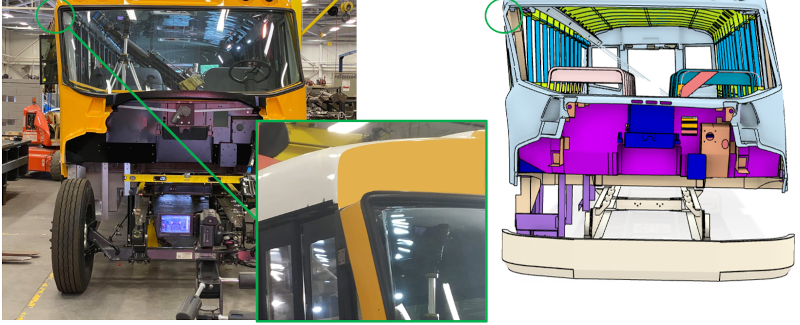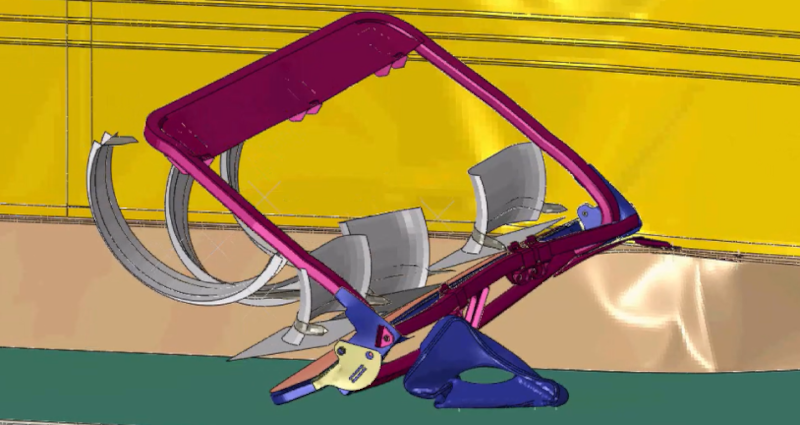
Perform physical vehicle crash testing only once
By Optimec Consultants
CAD/CAM/CAE PLM/PDM Aerospace Automotive
Sponsored by Optimec Consultants
Quebec’s Optimec Consultants leverages high-end FEA to realistically simulate vehicle FMVSS crash tests.

Optimec Consultants’ simulation of the Colorado Rack Test, using Dassault Systèmes’ FEA software, led to a series of structural reinforcements that helped a bus manufacturer pass the FMVSS physical test.
(Photo credit: Optimec Consultants)
For many in the engineering design industry, Finite Element Analysis may seem straightforward: Simplify and mesh the model, set material properties and boundary conditions, apply one or two static loads and let the solver do the heavy lifting.
While that may serve as a general description of the basic FEA many engineers employ on single parts, in reality, FEA is multi-layered discipline with widely differing levels of complexity. Move up to analyzing an assembly, for example, with its various joints, welds, fasteners and fuzzy boundaries, and the level of difficulty (and possibility of human error) scales considerably. Add in dynamic loads and/or non-linear behavior, and the challenge increases significantly again.
At the highest FEA level sits wildly chaotic scenarios, such as realistically simulating what happens to a vehicle during a roll-over or head-on collision. Such simulations must account for multiple dynamic loads applied over time to large assemblies that may contain hundreds of parts composed of everything from aluminum and steel to rubber and plastic.
Producing a realistic analysis of these applications requires sophisticated software tools that can crunch thousands of calculations to converge on a solution within a relatively short time frame. It also depends on highly trained specialist with expertise in, not only the software, but also intimate knowledge of the safety test conditions regulatory bodies require of vehicle manufacturers.
For more than 20 years, Laval, QC-based Optimec Consultants has been a trusted source of both: High-end FEA software and the engineering specialists to wield it. With experience in automotive, aerospace, industrial systems and consumer goods, the firm’s clients include international firms such as ABB, Honeywell and Raufoss Technology, as well as Canadian companies such as Héroux-Devtek, Barrière QMB, Ker-Train Research and Dana TM4, among many others.
According to Optimec’s lead Engineering Simulation Specialist, Benjamin Beckelynck, B.Ing., M.Sc., the firm’s clients depend on his team to keep the expensive and time-consuming process of physical testing to an absolute minimum. For those in the transport industry, who must meet multiple Federal Motor Vehicle Safety Standards (FMVSS), the prospect of failing a physical test and having to crash a custom-built, million-dollar prototype more than once is a nightmare scenario.
“Failing an FMVSS test is major; the client would need to spend another million dollars to build another prototype,” Beckelynck explains. “And then you need to wait for the test center to have availability to test again. The cost and all the production delays are major drawbacks. That’s the idea behind virtual testing. If you do the virtual testing, you only have to go test once and you’re good.”

Simulation of the NHTSA’s Seat Belt Assembly Anchorages test helped Optimec’s client pinpoint and fix a failure of the bus seat’s anchorage point to the bus wall, as well as several rivets in the floor.
(Optimec Consultants)
To perform those complex simulations, Optimec’s preferred tool is Abaqus/Explicit, a version of Dassault Systèmes’ SIMULIA software suite that specializes in dynamic, non-linear FEA applications. In addition to being as feature rich as similar software on the market, Beckelynck says Abaqus has the added benefit of being integrated with Dassault’s cloud-based 3DEXPERIENCE platform.
Since many industry clients already use CATIA for CAD design, he says Optimec’s analysts can leverage the 3DEXPERIENCE platform to create associative links to the original models in Abaqus. This streamlined workflow avoids the lengthy process of exporting and importing STEP or Parasolid files, required when using other FEA software.
“It’s common for a simulation to find a problem in a model that then has to be redesigned,” Beckelynck explains. “Once this design is modified by the designer, the simulation process starts again. With third-party software, that means you have to re-mesh the model, re-prepare the analysis, run it, solve it and then probably find another problem and repeat the process again. This iterative process is so painful, because everybody is sending files to each other and you have to redo the same work several times.”
“On the 3DEXPERIENCE platform, however, where everything is connected together, the designer’s design changes are connected to the mesh,” he adds. “When you click update, the mesh is updated, and then you click run and you run the simulation again. As a result, the whole iterative process is much faster in an integrated environment.”
While efficient, Abaqus/Explicit’s true power, Beckelynck says, is demonstrated by how closely Optimec’s simulations match results of real-word, physical testing. As evidence, he points to a series of simulations the company performed for a North American bus manufacturer that was developing an electric school bus model. Optimec was tasked with helping the bus maker modify its prototype in preparation for a number of FMVSS tests.
Those tests included the Colorado Rack Test, a standardized FMVSS test designed to validate the structural integrity of a bus in a rollover accident, as well as the regulatory agency’s seat belt assembly anchorage test (FMVSS 210). In fact, it was a prior failure of both these physical tests that prompted the bus maker to contact Optimec in hopes of avoiding potential costly re-tests.
Instead of actually rolling a prototype, the Colorado Rack Test mimics the forces involved by actuating multiple hydraulic jacks positioned diagonally along the bus’ interior. To pass, the actuators can’t defect more than 4 inches and the emergency exit must remain easy to open. Optimec’s simulation of the test on the prototype bus replicated its prior failure and led to a series of structural reinforcement.
Similarly, for the FMVSS 210 test, Optimec’s simulation pinpointed failure of the seat’s anchorage point to the bus wall, as well as several rivets in the floor and a potential failure of the seat itself, mirroring what occurred in the prototype’s prior failed physical test. Based on the FEA results, the Optimec team recommended specific reinforcements to the rivets line, anchorage point and seat structure.
In both cases, Optimec’s simulations of the modified designs predicted a successful test, which led to a subsequent passing grade on both FMVSS physical tests.
While this cycle of iterative virtual simulations informing targeted design changes in preparation for physical testing is a powerful, cost-saving tool, Beckelynck says an equally powerful capability of simulation goes largely under-utilized. Namely, feeding the results of a physical test back into the virtual simulation. By validating and refining the simulation accuracy with real word data, manufacturers then have the opportunity to explore multiple “what-if” scenarios not captured by standardized regulatory tests.
“We are passionate about what we do, and we want to help every customer we’re working with,” Beckelynck says. “By working with so many different customers, we have the chance to learn their product. Sometimes we know their product better than the designer, because we can visualize exactly how it’s behaving under certain conditions: What is efficient, what is not efficient, what could be improved and what could be optimized. You can’t get that with a physical test.”
“Many know virtual tests can save time and money and reduce time-to-market because the iterative design process is much faster and much cheaper than doing physical tests,” he adds. “What many don’t realize is that, with an accurate enough virtual simulation, they will learn so much about their product and gain an in-house expertise, which is so valuable to improve the next design.”
Optimec.ca
